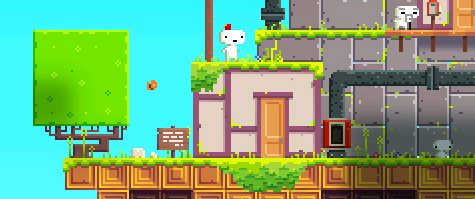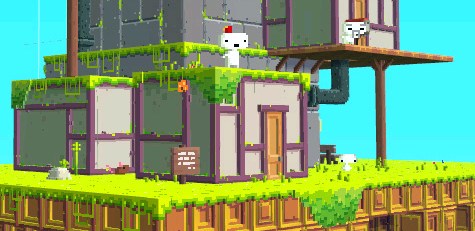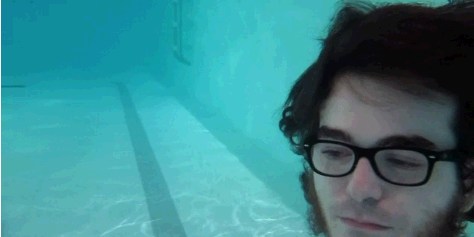
Featured Blog | This community-written post highlights the best of what the game industry has to offer. Read more like it on the Game Developer Blogs.
The Dimensions of Fez
My review of the Fez experience.

Fez is multiple. With all the mystery, controversy, and hype surrounding this game, it's important to find some perspective on what Fez is inside and outside of the game itself. Though it may be hard to effectively separate the fan from the fare, I believe explaining Fez as a poly-dimensional experience will help us understand the Fez experience. The following review contains some spoilers.
2D
Fez on the surface is not an easy game to attach a genre label on. Gomez, the main character, can JUMP, but there's not much do it. The stubby height and distance are mainly used for the most basic traversal. As far as platforming gameplay goes, you won't be maneuvering in your hang time, catching big air, or working out precisely where you want to land. If you try to engage with the dynamic of gravity, you'll be abruptly stopped. After a second of free fall, Gomez typically reaches "terminal" velocity and dies resetting players back to their position before the fall.

Players can ROTATE the view 90 degrees to bend space and engage in a physical way with the ambiguity of a 3D space in a 2D presentation. This core mechanic of Fez takes what would be bad3Dand turns it into mind bending interactivity in an Echochrome like fashion. While ROTATE is unique, few challenges use it to create deep puzzles; puzzles that can be thoroughly read according to their dynamics and interactions. A few of the better ROTATE puzzles are the bomb puzzles and some of thetower puzzles. With a truncated JUMP, limited vertical traversal, and the ability to ROTATE in two directions, there's not a lot of design space for most of Fez's challenges to work with. Most solutions are just one or two rotations away.
Yellow cube pieces are scattered throughout the environments. Many pieces are placed out in the open like Super Mario coins. Many are stashed behind doors. But for the most part, you navigate the environments in a very simple and straightforward way to get to these cubes. There's really almost nothing to it. The experience is so basic that it reminds me of the indie game Small Worlds.
Small Worlds succeeds with its short length, minimal complexity, and the ever widening 2D view that elegantly frames the player's progress. Fez stumbles over the complexity of its own world. The map and warp features are surprisingly complex. The map is an abstract representation of the abstract "open world" to begin with. And viewing it in 3D is particularly cumbersome. The warping system isn't useful enough to curb the significant backtracking across the areas that offer little unique and engaging interactivity. Such is the result of a world designed to be more open than it is focused, functional, or interesting. It's great to pick a direction and explore, but not when it comes at the cost of backtracking, getting lost, dead ends, and cold trails.
Fez presents a world to explore, but there's just not much to do along the linear journey until, like Gomez at the start of his adventure, you're eyes are opened to another dimension of Fez.
3D
The next dimension to Fez is a world rich in mystery, secrets, details, ideas, puzzles, and riddles. I make a very clear distinction between a puzzle and a riddle. A puzzle challenges a player's knowledge skills most of all. Solutions, which are typically few in number, can be derived (logically) from making a series of informed decisions. This means that puzzles typically present the player with all the rules up front so that the challenge comes from the dynamic interactivity of the system. By stressing knowledge skills puzzles can easily be spoiled, meaning once one learns the solution, it can be difficult to impossible for a player to experience the problem solving process ever again.
Riddles, in particular, are a type of puzzle that challenge players to think outside the box and come up with solutions that leap intuition gaps. Riddles are often the result of poorly designed puzzles. After all, providing insufficient information ultimately means there is some critical piece of information left out that the player needs to find a solution. It's easy for any designer to delete pieces, scatter parts, and otherwise obfuscate the data. Conveying meaning through art of any kind mostly involves presenting consistent and coherent ideas. This is why riddles and their obtuseness are often viewed negatively. It's as if the designer is working against the player. Read more about puzzle and riddle design here.

The third dimension of Fez mostly centers around discovering and solving riddles. These challenges are really like a whole other game. Aside from the 32 yellow cubes there are 32 anti-cubes to collect. To crack these riddles players must embrace codes, languages, messages, clues, and possibilities that exist outside of the "box" that the yellow cubes represent. I don't think it's wrong to say that the quest for the anti-cubes is what Fez is really about. If so, we've identified a clear design problem.
To make and uphold a puzzle solving experience a designer can't simply tell the player the answers to the challenges. But a designer can and should tell the player the rules so they can make informed decisions. Likewise, to make a riddle sufficiently obscure (in order to support a creative, out of the box type experience), a designer can't tell the player the answer or even all the rules at play. To achieve a level of secrecy, that sense of discovery, or that eye opening moment as you move from one dimension of thinking into a new world of possibilities, a designer has to obfuscate, or hide the clues. Nearly everything about the anti-cubes is hidden. Understanding how these design choices shape Fez is key.
The anti-puzzles of Fez are well hidden, but they're not impossible to find. I stumbled across this extra dimension of mystery by looking over the achievement list and noticing one that didn't fit the pattern: "RTRTLTRTRTLTLTLT" So I unpaused the game and inputted the sequence of seemingly random ROTATE moves. And so my eyes were opened. Before playing Fez I had intentionally avoided all spoilers and information about the game. Yet, when I stumbled onto the riddle filled dimension of mystery, somehow I knew it was there all along.
The point I'm trying to make is, it's obvious, at least in hindsight, why I knew there was more to Fez than just collecting yellow cubes. First, there's almost nothing to the challenges to collect yellow cubes. It's slow. It's not very challenging. Not very layered or complex. And there's not a lot of gameplay variation. I felt that there had to be more to Fez. Then there's the map. Areas with secrets yet to be discovered are clearly marked on the map. Yet, after scouring these areas I came up empty handed. There had to be a way. From the beginning I noticed the languages and symbols plastered into the background scenery of the world. I assumed the language could be learned. Before finding my first anti-cube I knew I was missing something. Move Left. Move Right. JUMP. ROTATE left. ROTATE right. And the occasional LIFT bomb. I thought, if this is all there is to the mechanics of Fez there had to either be new mechanics to acquire or.... Eureka.
From here Fez is a flurry of notes, scribbles, jotted ideas, and hunches built out of QXR, binary, ASCII, stereo rubble, Tetris, block language, cryptic phrases, pangram, poetry, hexahedron madness. This is what I was looking for from my Fez experience. In general, engaging with all types of experience has a way of transforming one's mind. But the way puzzles in particular shape the mind is worth noting. While playing Fez I thought about codes and shapes and possibilities. And when Fez was turned off my mind continued to churn in the background. I can't tell you the last time a game has had this kind of effect on me.
Wait. I can tell you the last time a game has had this kind of effect on me because it happens all the time. I have a similar kind of discovery, explorative, info dive by engaging video game stories and gameplay most of all. I've connected the subtle story details and world of Phantom Hourglass. I've dived head first into the details of Pokemon. In fact, I've taken more notes on Kid Icarus Uprising than I have on Fez. I take notes on all games to reveal their inner worlds, languages, and minds of their creators because these qualities are hard to separate from the art.
Fez isn't unique or innovative because it can be engaged on this extra dimension. Fez is unique because this dimension makes something else very apparent. And so we've come to the final dimension of Fez.
4D
It's Phil Fish. I really mean it. Fish has put so much of himself and his ideas into Fez that it's pretty obvious that by playing Fez we drop in deep over our heads into his world. Everything from the color pallets to the Tetris motif to the grand treasure hunt for cubes is straight out of Fish's mind. Yes, I believe I can see Fish clearly through his work, and this is what I've concluded.

image of Phil Fish from Indie Game: The Movie.
For a video game and gameplay, Fez is very poorly designed. In fact, Fez is my most disappointing gaming experience of the year. The game is designed in a very even toned, take what you want, wander where you will, find as much as you can way. This is to say that Fez doesn't have a strong overall progression like the games it appears to be. What I call the flat, 2D experience of Fez lacks challenge, depth, progression, and appropriate feedback/tutorials. Whether you think the yellow cubes or the anti-cubes are the core of Fez, both experiences are designed to be games; they aren't designed to convey meaning through the gameplay of informed decisions. No matter where you fall in the spectrum of where the best of Fez is, you're forced to play through a rough abstraction of an abstraction.
I recently cautioned against making games, which are abstractions, out of vague, high concecpt, or abstract sources. In Fish's case, instead of fully understanding the idea he wanted for Fez and how to design the idea into a video game medium, Fish took five years or so to discover what Fez is. In my experience, deisgners who have to discover what their games are over a long period of time either don't have a good gameplay idea to start from or they simply don't understand how to think in game design terms. I believe this is the case with Fez and Fish.
Fish is the one, after all, who said that "[Modern Japanese] games just suck." It's clear to me that Fish can learn volumes about game design from Japanese games new and old. I know I have. This blog is dedicated to explicating the undenyable excellent game design of Super Mario Brothers for the NES; a game that holds up against just about every kind of design analysis I've come up with over the last 4 years. If Fish would like to study a modern example of perfect Japanese puzzle/adventure games Fish could study Pushmo or 999.
It seems to me that by rejecting "Japanese game design" Fish rejected "good game design" as well. Fez has platforming elements, but doesn't develop solid platforming gameplay challenges. Fez builds a verticality to its levels, yet the "terminal velocity" reduces the dynamic emergence of gravity in 2D space. In Fez there's lots of places to go but traversal isn't very interesting and far from the core Fez experience if you believe that the anti-cubes are the real point of Fez. Fez has some of the design pieces of an adventure game, but none of the progression and structure that makes adventure games shine. Fez has the elements to create many deep puzzles around space and perspective, yet it focuses far more on traversal and riddles than puzzling.
In the end, Fez isn't designed to be a game (according to conventions). Rather, Fez is designed to be an experience. But even when I think of Fez as an experience with no "gamey" expectations, it still falls short. Fez is a collection of individual ideas and disjointed pieces. And like many amateur artists, Fish rejected foundational design principles in favor of what I imagine he felt was innovative or effective. By abstracting away from the abstraction of game design conventions, Fish created an experience that awkwardly strattles the line between game and non-game.
If you think that the dull "2D" elements of Fez work to create a contrast between the "3D" Fez experience, I'd say you're right. But this still doesn't excuse the many ways the dull 2D experience detracts from the whole. It's a classic "rookie" move to take the form the conventions of works within the medium and use them only as a subversion. It's a design mistake to put in so many elements into a work that are barely used or that are used in a way that works against the core. The biggest way the design of 2D Fez works against itself is by seeking to create an mysterious experience filled with exploration and riddles, Fish failed to leverage the power of abstraction.
Fish invited us into a world that is his world, filled with all the details he likes. When you play Fez, you dont pretend to translate messages from one language to another. You actually do it. In many ways, Fez is filled with these actual, "non-abstracted" experience. While this is a neat idea, it makes it very difficult to relate to. I'm not Fish. And I assume that you aren't either. What we need to best enjoy the world of Fish is some help; some guidance; some simplficiations; some abstraction. The reason that craft, design, and art works well is because artists find ways to simplify their expression in ways that allow their ideas and experiences to be conveyed through a medium. This is part of the work that the artist must do to spare their audience from working through the same kind of problems he/she did to come up with the ideas in the first place.
Fish reminds me of myself in some ways, especially when I think back on the way I used to write fiction. I was so obsessed with conveying these complex stories and high level ideas that I was missing the part of craft and design that makes conveying these things work best. I was so focused on being original and doing things "in my own style" that I didn't realize I was limiting myself.
It's too bad I don't like Fez that much. Its content is better than its execution. I love pixel art. I love flat shapes and simple geometric shapes. I love playing with 2D and 3D perspective. I love platformers. I love puzzle games. I love mysteries. I love codes. I love languages. And I love riddles. You would think Fez would be one of my favorite games. But ultimately, I love and defend gameplay; and I love design where designers use their expertise to craft a gameplay experience I can enjoy, understand, and ultimately learn from. Parts of Fez are great. What's great about the game is creative ideas and a strong sense of Fish. What's not so great is the gameplay part, which is the hardest part about making a game. To reject the rules is easy. To squeeze yourself as an artist and find the ways you can express yourself through the limitations of the medium is design.
Read more about:
Featured BlogsAbout the Author(s)
You May Also Like













